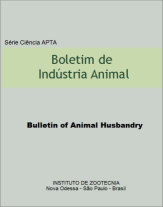Tympanic temperature as an indicator of heat stress in pregnant dairy sheep Lacaune breed
Keywords:
dairy sheep, rectal temperature, tympanic temperatureAbstract
In the last decade sheep production grew significantly and the sheep are one of the most exploited species in the world. West of Santa Catarina shows growth in the exploitation of these species especially dairy breeds. Adverse weather conditions may cause heat stress in animals which causes losses in productive and reproductive indexes. The body temperature is the main variable used to evaluate heat stress. Thus, infrared equipment is used because it is a noninvasive technique. The aim of this study was to evaluate the use of tympanic temperature as indicator of thermoregulatory state of dairy sheep. The study was conducted in Chapecó - SC, in February of 2014, for 15 days. Eighteen pregnant sheep (60 days of gestation) with average age of three and five years old were used. Environmental variables dry bulb temperature (Db) and wet bulb temperature (Wb) were taken hourly and the temperature and humidity index (THI) calculated. Respiratory rate (RR), tympanic temperature (TT) and rectal temperature (RT) were measured during the morning and afternoon. Mean values and standard deviations of environmental and physiological variables were calculated for general characterization of the data. The physiological and environmental data were used to analysis of Pearson correlation. The values of environmental and physiological variables were higher in the afternoon compared to the morning. There were significant positive correlation (P<0.05) between TT and RT (r = 0.05), and significant positive correlations (P<0.01) between TT and Db, THI, RR variables (r = 0.37, 0.35 and 0.48, respectively). Also observed significant positive correlations (P<0.05) between Db, THI, RR (r = 0.09, 0.08 and 0, 07) and the RT. The fact that the correlations between the TT and the environmental variables are higher than those found between RT and environmental indicates that noninvasive measurement (tympanic) can be used as indicator physiological measure of heat stress in pregnant sheep Lacaunes, may replace the rectal temperature. More studies regarding this subject in other thermal situations, breeding systems and breeds of sheep is suggested.Downloads
Downloads
Published
Issue
Section
License
Os autores não serão remunerados pela publicação de trabalhos, pois devem abrir mão de seus direitos autorais em favor deste periódico. Por outro lado, os autores ficam autorizados a publicar seus artigos, simultaneamente, em repositórios da instituição de sua origem, desde que citada a fonte da publicação original seja Boletim de Indústria Animal. A revista se reserva o direito de efetuar, nos originais, alterações de ordem normativa, ortográfica e gramatical, com vistas a manter o padrão culto da língua e a credibilidade do veículo. Respeitará, no entanto, o estilo de escrever dos autores. Alterações, correções ou sugestões de ordem conceitual serão encaminhadas aos autores, quando necessário. Nesses casos, os artigos, depois de adequados, deverão ser submetidos a nova apreciação. As opiniões emitidas pelos autores dos artigos são de sua exclusiva responsabilidade. Todo o conteúdo deste periódico, exceto onde está identificado, está licenciado sob a Licença Creative Commons Attribution (CC-BY-NC). A condição BY implica que os licenciados podem copiar, distribuir, exibir e executar a obra e fazer trabalhos derivados com base em que só se dão o autor ou licenciante os créditos na forma especificada por estes. A cláusula NC significa que os licenciados podem copiar, distribuir, exibir e executar a obra e fazer trabalhos derivados com base apenas para fins não comerciais.













